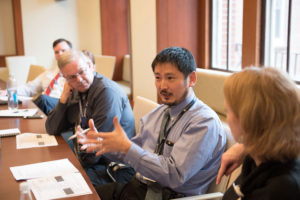
The opioid epidemic in the United States is entering its third decade, and Brigham and Women’s Hospital has had a longstanding commitment to deliver care to those facing addiction to opioids as well as alcohol and other drugs. The Brigham’s Bridge Clinic, established in 2018, is the latest program aimed at reducing barriers to treatment. The clinic provides urgent, on-demand care while also helping patients transition to other, longer-term programs.
“If you look around the country, the vast majority of people who have substance-use disorders are not receiving any treatment whatsoever—about 90 percent are unable to access care,” said Joji Suzuki, MD, director of the Division of Addiction Psychiatry in the Brigham’s Department of Psychiatry. “This is in contrast to conditions like diabetes or heart disease, where most people are receiving treatment.”
Over the past decade, the Brigham has undertaken many efforts to expand access to substance use-disorder treatment for people who need it. These include launching a comprehensive outpatient clinic, establishing addiction treatment programs in primary care settings and assisting hospital teams in managing patients with substance-use disorders hospitalized for acute medical reasons.
“What we began to realize pretty quickly is that when we offer treatment for substance-use disorders to hospitalized patients who have come to the Brigham for another condition, they’re very willing to start addiction treatment,” Dr. Suzuki said. “But addiction treatment is relatively scarce, and patients often needed to wait weeks or even months to begin treatment. This was the primary motivation for the creation of the Bridge Clinic.”
A Walk-In Clinic With Several Paths of Referral
The Bridge Clinic, which is open during regular daytime hours as well as Tuesday evenings, is designed as a walk-in clinic. Although patients are asked to make appointments, it is set up to offer care whenever people show up. One reason the clinic can operate this way is that it is funded primarily by philanthropic support, rather than a fee-for-service model. Plans call for the clinic to expand its evening hours and open on weekends in the future.
“Our goal is to be flexible and to keep access as open as possible. This really flies in the face of how most hospitals have done addiction treatment in the past and all the barriers that have existed,” Dr. Suzuki said. “People are used to being given a list of phone numbers to call and then sent on their way. We are focused on retaining them in our clinic until we can help them get somewhere else.”
Patients are referred to the Bridge Clinic in many different ways. They may come through the emergency department, inpatient units, an outpatient clinic or one of the Brigham’s outpatient addiction programs.
A distinguishing feature of the Bridge Clinic is that it provides basic medical and psychiatric care in addition to addiction treatment. “The clinic includes primary care physicians, addiction psychiatrists, a nurse practitioner, a women’s health specialist, a peer recovery coach and a resource specialist,” Dr. Suzuki said. “We also have the ability to manage infectious disease complications, such as HIV, hepatitis C and bacterial infections, which are somewhat common in this population.”
The clinic staff also features recovery coaches who are in recovery themselves and help motivate and inspire patients.
Early Success in a Challenging Patient Population
Dr. Suzuki said that in the first year of the program, close to 200 patients were referred to the Bridge Clinic, and just under 90 percent showed up. The team is continuing to collect patient outcomes and plans to report on these soon, but the early signs indicate the program has been very successful in bridging patients to community programs for longer-term treatment.
“We’ve been very surprised at how good these outcomes are because this is a very challenging population to treat,” he concluded. “Many are homeless, and many have other medical comorbidities. The staff has done a tremendous amount of work to retain patients and to bridge them to other programs. I’m very proud of what we’ve accomplished so far.”